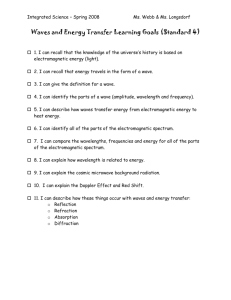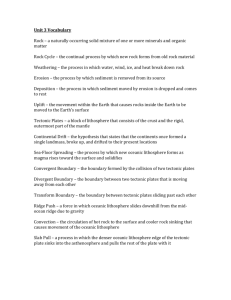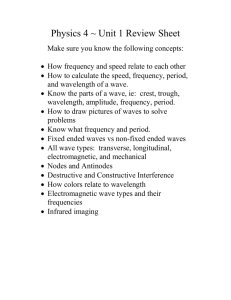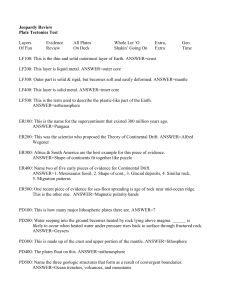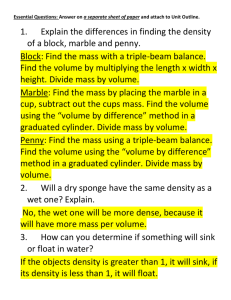File 8th Grade Science Vocabulary Review GAME!.
advertisement
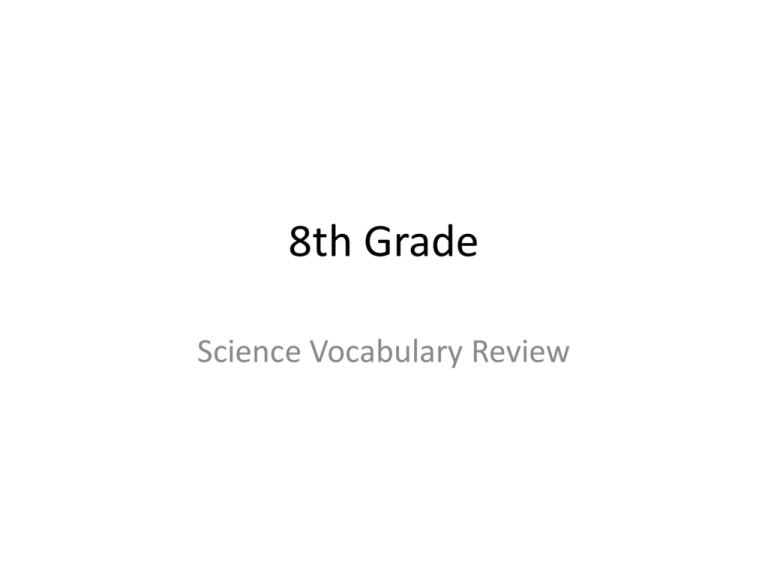
8th Grade Science Vocabulary Review The actual brightness of a star ABSOLUTE MAGNITUDE The transfer of energy carried by light waves to particles of matter ABSORPTION A characteristic that helps an organism survive and reproduce in its environment ADAPTATION A large body of air that has the same temperature and moisture throughout AIR MASS Alternate forms of a gene that govern the same characteristics ALLELES The maximum distance the particles of a wave’s medium vibrate from their rest position AMPLITUDE How bright a light appears to an observer APPARENT MAGNITUDE A measure of how much surface an object has AREA The study of all physical objects beyond Earth ASTRONOMY The smallest particle into which an element can be divided and still be the same substance ATOM The weighted average of the masses of all the naturally occurring isotopes of an element ATOMIC MASS The number of protons in the nucleus of an atom ATOMIC NUMBER The state in which the combined forces exerted on an object add up to zero BALANCED The theory that states that the universe began with a tremendous explosion BIG BANG THEORY An object with more than three solar masses squeezed into a ball only 10 km across whose gravity is so strong that not even light can escape BLACK HOLE The movement of carbon from the nonliving environment into living things and back CARBON CYCLE The largest population that a given environment can support over a long period of time CARRYING CAPACITY The idea that all geologic change happens suddenly CATASTROPHISM The process by which sediment is “glued” together by minerals dissolved in water CEMENTATION The force of attraction that holds two atoms together CHEMICAL BOND The joining of atoms to form new substances CHEMICAL BONDING A change that occurs when one or more substances are changed into entirely new substances with different properties CHEMICAL CHANGE A shorthand description that uses chemical formulas to describe a chemical reaction CHEMICAL EQUATION A shorthand notation that uses chemical symbols and numbers to represent a substance CHEMICAL FORMULA The process by which one or more substances change to produce one or more different substances CHEMICAL REACTION A number placed in front of a chemical symbol or formula COEFFICIENT The process by which soft sediment is squeezed until it hardens into rock COMPACTION A pure substance composed of two or more elements that are chemically combined COMPOUND The theory that continents can drift apart from one another and have done so in the past CONTINENTAL DRIFT The process by which cooler material sinks while warmer material rises because of a change in density CONVECTION The boundary between two colliding tectonic plates CONVERGENT BOUNDARY A bond that results from the attraction between the nuclei of atoms where the electrons are shared by the atoms COVALENT BOND Any pieces of information gathered through experimentation DATA The process of clearing forests DEFORESTATION To change shape because of the action of geologic processes DEFORM The amount of matter in a given space or volume DENSITY The boundary between two tectonic plates that are moving away from each other; rift zone DIVERGENT BOUNDARY The trait observed when at least one dominant allele for a characteristic is inherited DOMINANT TRAIT The apparent change in frequency of a sound caused by the motion of either the listener or the source of the sound DOPPLER EFFECT A community of organisms and their nonliving environment ECOSYSTEM The entire range of electromagnetic waves, all the wavelengths of electromagnetic radiation ELECTROMAGNETIC SPECTRUM A wave that can travel through space and matter and consists of vibrating electric and magnetic fields ELECTROMAGNETIC WAVE A negatively charged subatomic particle that is found in all atoms ELECTRONS A region inside an atom where electrons are likely to be found ELECTRON CLOUD A pure substance that cannot be separated into simpler substances by physical or chemical means ELEMENT A spherical or elongated galaxy with a bright center and very little dust and gas ELIPTICAL GALAXY A periodic change in the location of warm and cool surface waters in the Pacific Ocean EL NINO The term used to describe a physical or chemical change in which energy is absorbed ENDOTHERMIC Regions around the nucleus of an atom where electrons may be found ENERGY LEVELS The process by which wind, water, ice, and gravity remove and transport material from one place to another EROSION The term used to describe a physical or chemical change in which energy is given off EXOTHERMIC The type of strain that occurs when rocks break because of stress FAULTING A messaging system that the body uses to maintain equilibrium FEEDBACK MECHANISM The type of strain that occurs when rocks bend because of stress FOLDING The number of waves made in a given amount of time FREQUENCY The area where two different air masses meet FRONT A large grouping of stars in space GALAXY The inherited combination of alleles GENOTYPE The scientific study of the Earth’s history GEOLOGY Each vertical column of elements (from top to bottom) on the periodic table GROUP The transfer of energy between objects that are at different temperatures HEAT Hertzsprung-Russell diagram showing the relationship between a star’s surface temperature and absolute magnitude H-R DIAGRAM A large, spinning tropical weather system with wind speeds of at least 119 km/h HURRICANE A possible explanation or answer to a question HYPOTHESIS Rock that forms when hot, liquid rock cools and hardens IGNEOUS ROCK The force of attraction between oppositely charged ions IONIC BOND A galaxy that does not fit into any other category IRREGULAR GALAXY The energy of motion KINETIC ENERGY Magma that reaches the Earth’s surface LAVA The law that states that mass is neither created nor destroyed in ordinary chemical and physical changes LAW OF CONSERVATION OF MASS A UNIT OF LENGTH EQUAL TO THE DISTANCE THAT LIGHT TRAVELS THROUGH SPACE IN 1 YEAR LIGHT-YEAR Literally, the “rock sphere” – the cool, rigid, outermost layer of the Earth that is divided into enormouse pieces called tectonic plates LITHOSPHERE The orbit of the moon around the Earth, during which all of the lunar phases occur LUNAR CYCLE The different appearances of the moon throughout the month LUNAR PHASES The diagonal pattern of stars on the H-R diagram; where stars spend most of their time MAIN SEQUENCE The solid layer of the Earth between the crust and the core; made of dense iron rich minerals MANTLE The amount of matter that something is made of MASS The total number of protons and neutrons in an atom MASS NUMBER Anything that has volume and mass MATTER A substance through which a wave can travel MEDIUM Rock that forms when existing rock is heated and squeezed deep inside the Earth METAMORPHIC ROCK EM waves that are between radio waves and infrared waves in the electromagnetic spectrum MICROWAVES Underwater mountain chain that forms on the ocean floor where tectonic plates pull apart MID-OCEAN RANGE A naturally formed inorganic rock solid that has a repeating three-dimensional structure MINERAL A representation of an object or system MODEL A neutral group of atoms held together by covalent bands MOLECULE The process by which organisms with certain traits survive and reproduce at a higher rate then organisms without these traits NATURAL SELECTION Tides with the smallest daily tidal range that occur during the first and third quarters of the moon NEAP TIDES A star in which nearly all the particles have become neutrons NEBULA A subatomic particle of the nucleus of an atom that has no charge NEUTRON A large cloud of dust and gas in interstellar space NEBULA The movement of nitrogen from the nonliving environment into living things and back NITROGEN CYCLE The tiny, very dense, positively charged region in the center of an atom NUCLEUS A streamlike movement of water in the ocean OCEAN CURRENT A symbiotic association in which one organism benefits while the other is harmed Parasitism Each horizontal row of elements (from left to right) on the periodic table PERIOD An arrangement of the elements according to their atomic numbers PERIODIC TABLE OF THE ELEMENTS An organism’s appearance PHENOTYPE The theory that the lithosphere is divided into tectonic plates that move around on top of the asthenosphere PLATE TECTONICS Water, in a solid or liquid form, that falls from the air to Earth PRECIPITATION A substance formed from a chemical reaction PRODUCT A positively charged subatomic particle of the nucleus of an atom PROTON EM waves with long wavelengths and low frequencies RADIO WAVES A starting material in a chemical reaction REACTANT A trait that is apparent only when two recessive alleles for the same characteristic are inherited RECESSIVE TRAIT The process of breaking down trash and using the materials again RECYCLING The bouncing back of a wave after the wave hits a barrier REFLECTION A natural resource that can be used over and over or that has an unlimited supply RENEWABLE RESOURCE The continual process by which new rock is formed from old rock ROCK CYCLE The ways in which scientists answer questions and solve problems SCIENTIFIC METHODS The process by which new oceanic lithosphere forms at mid-ocean ridges as tectonic plates are pulled away from each other SEA-FLOOR SPREADING Rock that forms when pieces of rocks or minerals are “glued” together SEDIMENTARY ROCK The amount of energy needed to change the temperature of 1 kg or a substance by 1ºC SPECIFIC HEAT CAPACITY The rainbow of colors produced when white light passes through a prism or spectrograph SPECTRUM A galaxy with a bulge in the center and very distinctive spiral arms SPIRAL GALAXY Tides that have the largest daily tidal range and occur during the new and full moons SPRING TIDE The amount of force per unit area that is put on a rock STRESS The region where oceanic lithosphere sinks down into the asthenosphere at a convergent boundary SUBDUCTION ZONE A close, long-term association between two or more species SYMBIOSIS A number written below and to the right of a chemical symbol in a formula SUBSCRIPT Huge pieces of the lithosphere that move around on top of the asthenosphere TECTONIC PLATES A measure of how hot (or cold) something is TEMPERATURE A unifying explanation for a broad range of hypotheses and observations that have been supported by testing THEORY Daily changes in the level of ocean water TIDES The boundary between two tectonic plates that are sliding past each other TRANSFORM BOUNDARY The lowest point of a wave TROUGH EM waves that are between visible light and X rays in the electromagnetic spectrum ULTRAVIOLET WAVES The state in which the combined forces exerted on an object do not add up to zero UNBALANCED All space and the matter space contains UNIVERSE The rising of regions of Earth’s crust to higher elevations UPLIFT The electrons in the outermost energy level of an atom VALENCE ELECTRONS A process in which cold, nutrient-rich water from the deep ocean rises to the surface and replaces warm surface water UPWELLING The movement of water through the atmosphere, the ground, bodies of water, and living things WATER CYCLE A disturbance that transmits energy through matter or space WAVE The distance between any two corresponding points that are adjacent on a wave WAVELENGTH The condition of the atmosphere at a certain time and place WEATHER The time required for the Earth to revolve once around the sun YEAR The tendency of all objects to resist any change in motion INERTIA The bending of a wave as the wave passes at an angle REFRACTION A wave that travels only through matter by creating vibrations in a medium MECHANICAL WAVES Properties that DO NOT change the chemical nature of matter PHYSICAL PROPERTIES Elements that are grouped together based on their chemical properties and reactivity FAMILIES / GROUPS The passing of light through matter TRANSMITTED Push or Pull – measured in (N) Newtons FORCE The highest point on a wave CREST An abbreviation of a chemical element using one or two letters CHEMICAL SYMBOL The force of attraction between two objects GRAVITY Causes a change in the speed or direction of an object’s motion UNBALANCED FORCES The very narrow range of wavelengths and frequencies in the electromagnetic spectrum that humans can see VISIBLE LIGHT Properties that DO change the chemical nature of matter CHEMICAL PROPERTIES The transfer of energy through matter or space as electromagnetic waves, such as visible light and infrared waves RADIATION A star in which nearly all of the particles have become neutrons NEUTRON STAR The transfer of energy from one substance to another through direct contact CONDUCTION The gel-like fluid mixture inside a cell CYTOPLASM Usually found in plant cells where photosynthesis takes place CHLOROPLASTS The part of the microscope that holds the slide in place on the stage STAGE CLIPS The part of the microscope that supports the slide and allows light to come through STAGE The part of the microscope that you put your eye on to look at an organism EYEPIECE The part of the microscope that supports the eyepiece and maintains the correct distance from the eyepiece and the objectives BODY TUBE The part of the cell that destroys worn out or damaged organelles and gets rid of waste material LYSOSOME The part of the cell that burns food molecules to release energy MITOCHONDRIA A group of organisms that lack a cell nucleus. Single-celled organisms like bacteria PROKARYOTES The organelle that packages and transports material out of the cells GOLGI BODIES The outermost structure of a plant cell that provides strength and support CELL WALL Large vesicles found in plant cells that store water and other liquids VACUOLES The outer membrane of a cell that controls movement in and out of the cell CELL MEMBRANE A fault in which the hanging wall moves down because of tension NORMAL FAULT Hot, liquid rock material MAGMA A fault in which the hanging wall moves up because of compression REVERSE FAULT The presence of harmful or unwanted levels of substances in the environment POLLUTION A fault in which the plates move horizontally past each other because of shearing STRIKE-SLIP FAULT A force that causes rocks to be pulled apart TENSION The circular motion of liquids or gases caused by density differences that result from temperature differences CONVECTION CURRENTS A force that causes rocks to slide horizontally past each other SHEARING The process by which sediments are deposited / dropped in a new location DEPOSITION The type of stress in which an object is squeezed, as when two plates collide COMPRESSION The process by which water, ice, wind, and heat act to break down rocks WEATHERING The organelle that makes proteins RIBOSOME
